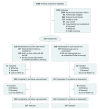Effect of a Collaborative Care Intervention vs Usual Care on Health Status of Patients With Chronic Heart Failure: The CASA Randomized Clinical Trial
- PMID: 29482218
- PMCID: PMC5876807
- DOI: 10.1001/jamainternmed.2017.8667
Effect of a Collaborative Care Intervention vs Usual Care on Health Status of Patients With Chronic Heart Failure: The CASA Randomized Clinical Trial
Abstract
Importance: Many patients with chronic heart failure experience reduced health status despite receiving conventional therapy.
Objective: To determine whether a symptom and psychosocial collaborative care intervention improves heart failure-specific health status, depression, and symptom burden in patients with heart failure.
Design, setting, and participants: A single-blind, 2-arm, multisite randomized clinical trial was conducted at Veterans Affairs, academic, and safety-net health systems in Colorado among outpatients with symptomatic heart failure and reduced health status recruited between August 2012 and April 2015. Data from all participants were included regardless of level of participation, using an intent-to-treat approach.
Interventions: Patients were randomized 1:1 to receive the Collaborative Care to Alleviate Symptoms and Adjust to Illness (CASA) intervention or usual care. The CASA intervention included collaborative symptom care provided by a nurse and psychosocial care provided by a social worker, both of whom worked with the patients' primary care clinicians and were supervised by a study primary care clinician, cardiologist, and palliative care physician.
Main outcomes and measures: The primary outcome was patient-reported heart failure-specific health status, measured by difference in change scores on the Kansas City Cardiomyopathy Questionnaire (range, 0-100) at 6 months. Secondary outcomes included depression (measured by the 9-item Patient Health Questionnaire), anxiety (measured by the 7-item Generalized Anxiety Disorder Questionnaire), overall symptom distress (measured by the General Symptom Distress Scale), specific symptoms (pain, fatigue, and shortness of breath), number of hospitalizations, and mortality.
Results: Of 314 patients randomized (157 to intervention arm and 157 to control arm), there were 67 women and 247 men, mean (SD) age was 65.5 (11.4) years, and 178 (56.7%) had reduced ejection fraction. At 6 months, the mean Kansas City Cardiomyopathy Questionnaire score improved 5.5 points in the intervention arm and 2.9 points in the control arm (difference, 2.6; 95% CI, -1.3 to 6.6; P = .19). Among secondary outcomes, depressive symptoms and fatigue improved at 6 months with CASA (effect size of -0.29 [95% CI, -0.53 to -0.04] for depressive symptoms and -0.30 [95% CI, -0.55 to -0.06] for fatigue; P = .02 for both). There were no significant changes in overall symptom distress, pain, shortness of breath, or number of hospitalizations. Mortality at 12 months was similar in both arms (10 patients died receiving CASA, and 13 patients died receiving usual care; P = .52).
Conclusions and relevance: This multisite randomized clinical trial of the CASA intervention did not demonstrate improved heart failure-specific health status. Secondary outcomes of depression and fatigue, both difficult symptoms to treat in heart failure, improved.
Trial registration: clinicaltrials.gov Identifier: NCT01739686.
Conflict of interest statement
Figures
References
-
- Walke LM, Gallo WT, Tinetti ME, Fried TR. The burden of symptoms among community-dwelling older persons with advanced chronic disease. Arch Intern Med. 2004;164(21):2321-2324. - PubMed
-
- Bekelman DB, Havranek EP, Becker DM, et al. . Symptoms, depression, and quality of life in patients with heart failure. J Card Fail. 2007;13(8):643-648. - PubMed
-
- Heidenreich PA, Spertus JA, Jones PG, et al. ; Cardiovascular Outcomes Research Consortium . Health status identifies heart failure outpatients at risk for hospitalization or death. J Am Coll Cardiol. 2006;47(4):752-756. - PubMed
-
- Rumsfeld JS, Havranek E, Masoudi FA, et al. ; Cardiovascular Outcomes Research Consortium . Depressive symptoms are the strongest predictors of short-term declines in health status in patients with heart failure. J Am Coll Cardiol. 2003;42(10):1811-1817. - PubMed
Publication types
MeSH terms
Associated data
LinkOut - more resources
Full Text Sources
Other Literature Sources
Medical
Miscellaneous


